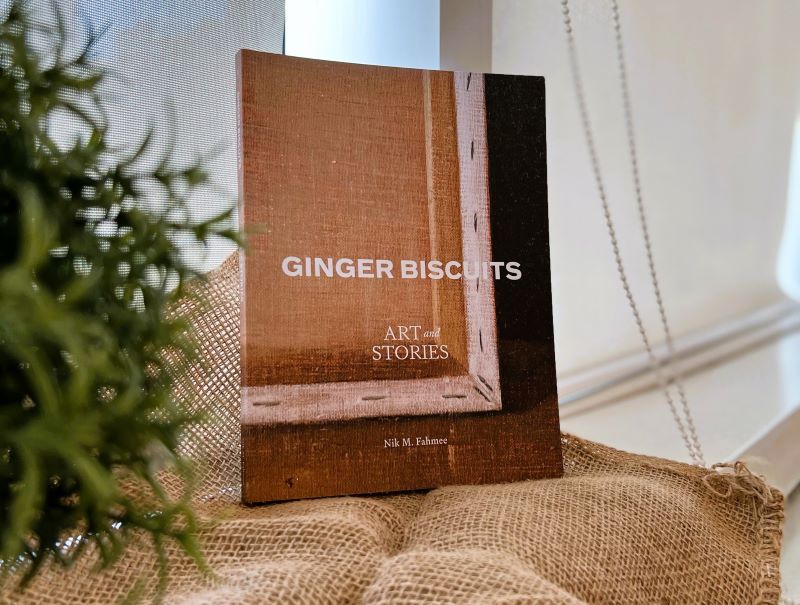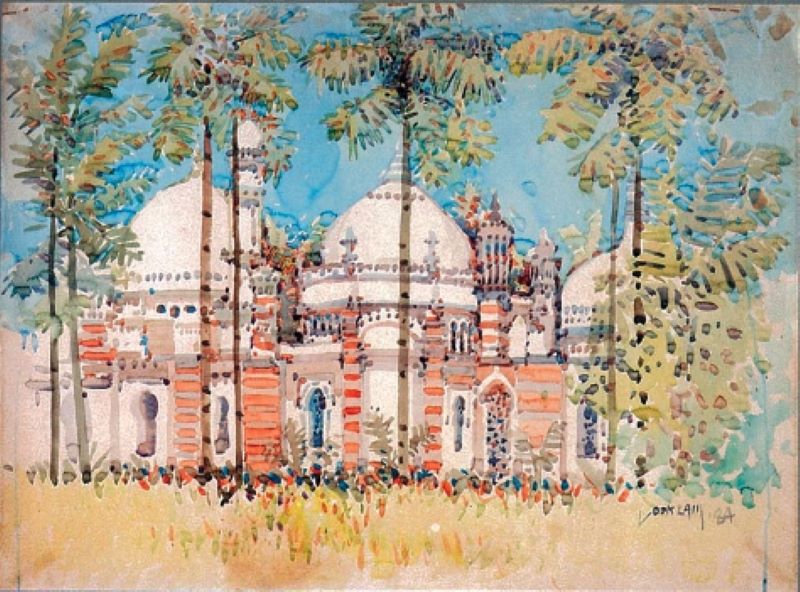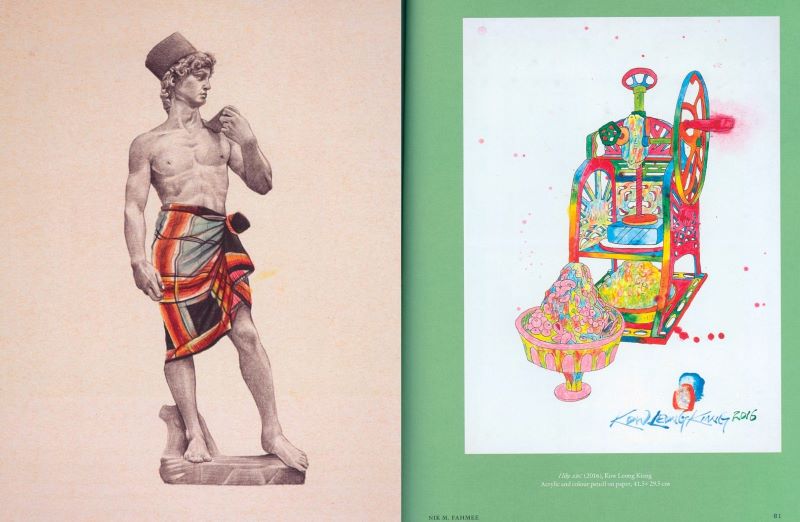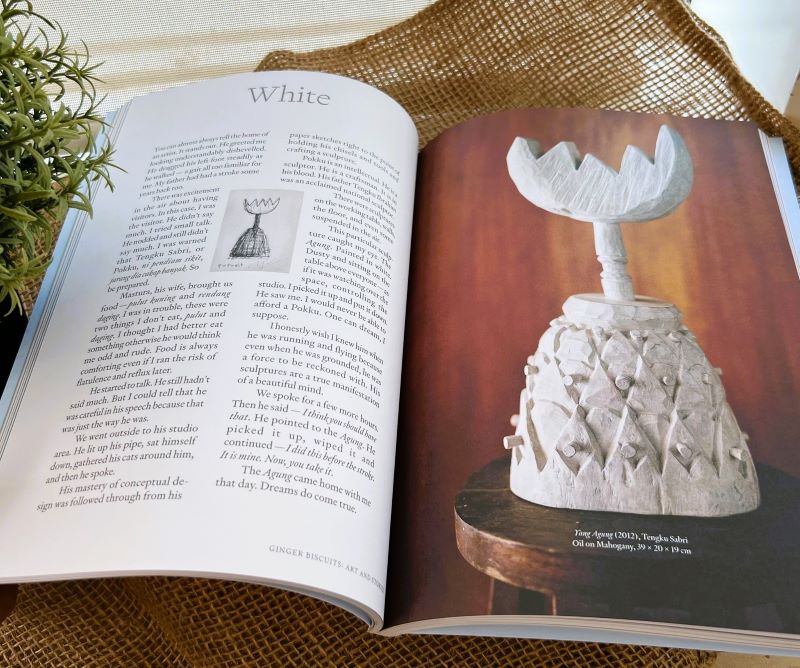
Nik, who turns 51 in August, is bringing out a second compilation of 51 stories with artworks (Photo: Low Yen Yeing/The Edge Malaysia)
Trapped at home by the Movement Control Order, Nik M Fahmee started taking photos of the paintings on his walls and some others he had collected over two decades. With time on his hands, he began writing vignettes about his experiences collecting art, visiting artists in their studios and understanding their mind, passion and purpose.
Art also triggered memories of his childhood in Penang in the 1980s, caring for his late parents and raising four children. He wrote these down too and shared them on Instagram. Until then, he had never posted anything. But The Wife (aka Nora Ismail) was not thrilled about his opening their door to strangers. His children insisted he make his account private. “So, I kind of tapered it down a bit,” Nik says.
Over the pandemic years, he wrote more than 500 stories. “There is always a story that connects to the artworks I collect.” When he turned 50 last year, he picked out 50 and self-published Ginger Biscuits — Art and Stories. The book documents his journey as a collector and that of the artists.
Nik, who turns 51 in August, is bringing out a second compilation of 51 stories with artworks. Butterflies in My Stomach will be launched at Cult Gallery, Kuala Lumpur, on June 10. The book takes its title from an ink-on-paper drawing — Chagar Hutang Turtle Sanctuary, Redang Island (2000) by Chang Fee Ming — which graces the cover.
Every snippet in both books completes the art for Nik. Collecting art has been a personal journey for him, and so are his stories. What is amazing is that he had never written before and was a “complete newbie rookie” who knew nothing about publishing. Truly, it was the MCO, he adds, as well as the push of friends, particularly former journalists Rose Ismail and Marina Mahathir, who told him, “You’ve got to do this.” There were many others who helped read, review and suggest edits.
ginger_biscuits.jpg

“I enjoy collecting art and I love reading the stories behind artworks from the perspective of art critics, writers and historians. But never did I think I would write a book about it.”
He did, and beautifully, too. His vignettes are personal, funny and quiet. They are about everyday things that affect him and those he loves, about meeting and getting to know artists and why their works speak to him. He keeps them short, putting down what comes to mind to capture emotions as real and fast as possible. Succinct and true, Nik’s stories hit a chord because he bares his soul and brings art within the reach of those who know little or nothing about it.
On how he came out with them, he writes: “I start at the beginning with some simple truths; I add raw emotions with a spoonful of honey and honesty. I coat them with passion and drizzle facts. Then, it gets moulded and baked into a book. I don’t cook nor do I bake. I am also a man who didn’t write when I started writing. I should add naivety into the mix too.”
Putting himself out there means Nik, who The Wife says is a very private man, cannot retreat to his cave. “Yeah, that’s a bit of a disaster,” he admits. But there is another objective to his bringing out the books.
“When we eventually pass on the paintings to the children for their own collection, I don’t want it to just be aesthetics on the wall. I want them to know why I bought a painting and to understand why I collect art, my passion. I also want the children to appreciate our life stories and what we’ve gone through. It’s a way of documenting the collection and our world through anecdotes and vignettes.”
Nik focuses more on his childhood and family in Ginger Biscuits, whereas Butterflies slants towards the creative talents behind what graces his walls, his experience of collecting art and his encounters with artists, many of whom have become friends. One of them is Lat, who, for him, encapsulates art and stories. His touching account of the phone call from the cartoonist — “My heart stopped... My tongue seemed to have disappeared” — and how he got him to do the Foreword for his new publication set the tone for what lies between the pages.
29_page-0001.jpg

“When I finally got my wits about me, I told him that I was compiling stories for a second book and asked whether he would write something for me. A foreword. He said he doesn’t write but he can draw. I laughed, of course he can draw.”
Lat’s drawing now hangs in Nik’s Shah Alam home, among paintings and sculptures which tell wistful stories that leave a lump in the throat. First night, which opens the book, is accompanied by Putih (2021), Atiqah Khairul Anwar’s oil on canvas. It is about his 18-year-old grandmother — who used to tell him genial and warm stories — sitting on the edge of her nuptial brass bed, not knowing what was going to happen next.
“All she had running in her head was, ‘Please let him be handsome and nice. Tak tau putih ke, hitam ke. Hidung senget ke.’ She knew her parents would not have married her off to just anyone.”
Penang-born Nik studied there until he left for Universiti Utara Malaysia in Kedah. His was a very normal childhood, safe under the ketiak [armpit] of his schoolteacher mother. His father, who could paint very well, worked with the Penang Port commission and then the general hospital.
His home state figures in Pelangi George Town (2021), which brings back memories of briyani after Friday prayers, getting a mirror for free from Che Din’s antique shop on Carnarvon Street after the owner recognised his mother, and Aunty Lee, who brought his father kueh kapit after taking longer than he expected to repair his lounge chair.
Badrulzaman Abu’s Teloq Sepapan — Siri PKP ‘Lockdown’ (2021) makes him miss the simple life of walking with an egg in hand to the mee goreng stall so he could save 10 sen, or sekupang. Wong Hoy Cheong’s Figure Study 3 (c. 1990-94) takes Nik back to the first time they met and how — as they reminisced about their alma mater, Penang Free School — the artist, who initially looked guarded and careful, tenderly opened up.
nik_3.jpg

Nik, whose grandfather came to Malaya from India, confesses he grew up not wanting to be known as a mamak. Stephen Menon’s Aku Bukan Keling (2020) reminds him that you are who you are. He feels for Hisyamuddin Abdullah, who is frustrated about artists being pushed around, making him feel like a cow that was expected to always deliver, captured in Artist as Animal (2016).
Names Picked is a sweet story about how The Wife (then girlfriend) revealed what she would call her future children on their second date. “I should have just paid for the meal and run,” Nik writes. Looking at Eeman, Ehsan, Elham and Ekhlas (2021), the names of their children carved and sculpted from kayu balau by Burhanuddin Bakri, he must thank his lucky stars he did not.
Donald Abraham’s Skatedog I and II (2019)made from discarded skateboards that were cut and then painted, fulfilled a childhood dream that Nik and his sisters had of having skateboards and puppies, to which their parents said a vehement no. Untitled (2017), which hints at nudity, is playful and light, with subtle humour. It is by young Arikwibowo Amril, who reminds him of artists who want to learn and go beyond what is easy and shown.
One painting takes a dig at politicians who party-hop; another, in his first book, decries deforestation. Jamil Mat Isa’s Sitampok manggis, 1998 prompts the question of why art is always a secondary option, if it even was one, compared to academic subjects. Nik relates how Samsudin Wahab aka Buden, now a firm friend, told him he would trade his painting, Heaven and hell. Just one breath away! for all the money he had in his wallet. That was how this collector came to own his very first Buden, for RM5!
In the titular Butterflies in My Stomach, readers meet students from a special needs class who had to pitch ideas on how to improve their semi-rural school in Sarawak. The event was the inaugurual YayasanAMIR Social Business Cup. Student Shamir said, “Saya takut, butterflies saya besar sangat ni”, when Nik, the project host, shared that he was nervous about going on stage too. When the winner was announced, Shamir fell to the ground in sujud syukur. Nik cried so much, he was a mess.
Chang is among the 15 artists whose works feature in both books. Others include Khalil Ibrahim (the first artwork Nik brought home was by him), Ahmad Zakii Anwar, Kow Leong Kiang, Fadilah Karim and Hamir Soib.
book.jpg

“For me, they have to appear again because the books are not just about the art but also the stories. I wanted to have the strength of both. There are also the relationships,” Nik explains.
He feels not enough has been written about the relationship between people and artists. “A lot of the art stories and books are very jargonistic, very difficult to grasp and understand. I wanted to put a different spin on it. I wanted to look at artists as intellectuals, as human beings with their own sense of vulnerability and passion, and the human connection to them.
“I appreciate the intellectual write-up because I think that it is important to understand why the [choice of] materials, the background, the shadow play, the whole works. That’s important.
“But I also think people need to understand that relationship you have, or want to have, with artists, and the thinking behind their joy, their pain, their frustration. These are some of the things I have tried to put into this book, peppered with my personal stories.”
As someone who started buying art more than two decades ago, Nik notices younger and newer collectors viewing it as an investment these days.
“I don’t know whether it’s fair to say ‘these days’, maybe it was also happening in the past. There are many reasons people collect art, one being that it will appreciate in value. I kind of stay away from the transactional point of view because I have to like what I buy. It can be really expensive, but if I don’t like it, I don’t like it.”
Nik’s collection is vast and varied, from sketches and etchings to landscapes, abstracts, impressionism and mixed media pieces. Naturally, prices have shot up over the years. “Some of the artworks I used to buy in the past, I can’t afford now. There are some you cannot even find” — a fact that makes things even more interesting for collectors today.
This article first appeared on June 5, 2023 in The Edge Malaysia.


